Want to visit Gomukh in Uttarakhand, India, start of the River Ganga? Here’s a guide to trekking to the start of the Ganges river with everything you need to know.
I can’t believe I’m standing here.
Here at Gomukh, starting point of the Bhagirathi River, believed to be the source of the holy Ganges (Ganga).
After traveling the length of the Ganges across India and Bangladesh over the past year, I was determined to reach its starting point… but the odds were against me.
Traveler’s illness kept me far from food and close to the toilet for the past week. My malnourished body couldn’t handle the exertion of the trek; I was bedridden with exhaustion and symptoms of AMS all of yesterday evening. Fresh snowfall obscured the trail overnight, and being the first ones out, my friends and I wasted hours climbing over snowy boulders trying to find the way.
Despite all that, we made it.
My bare hands trail over the icy wall covering the mouth of Gangotri Glacier in awe. Laughter bubbles up from inside, and I do a victorious happy dance on ice. Suddenly I slip down to my knees in the snow, but no matter; I made it!
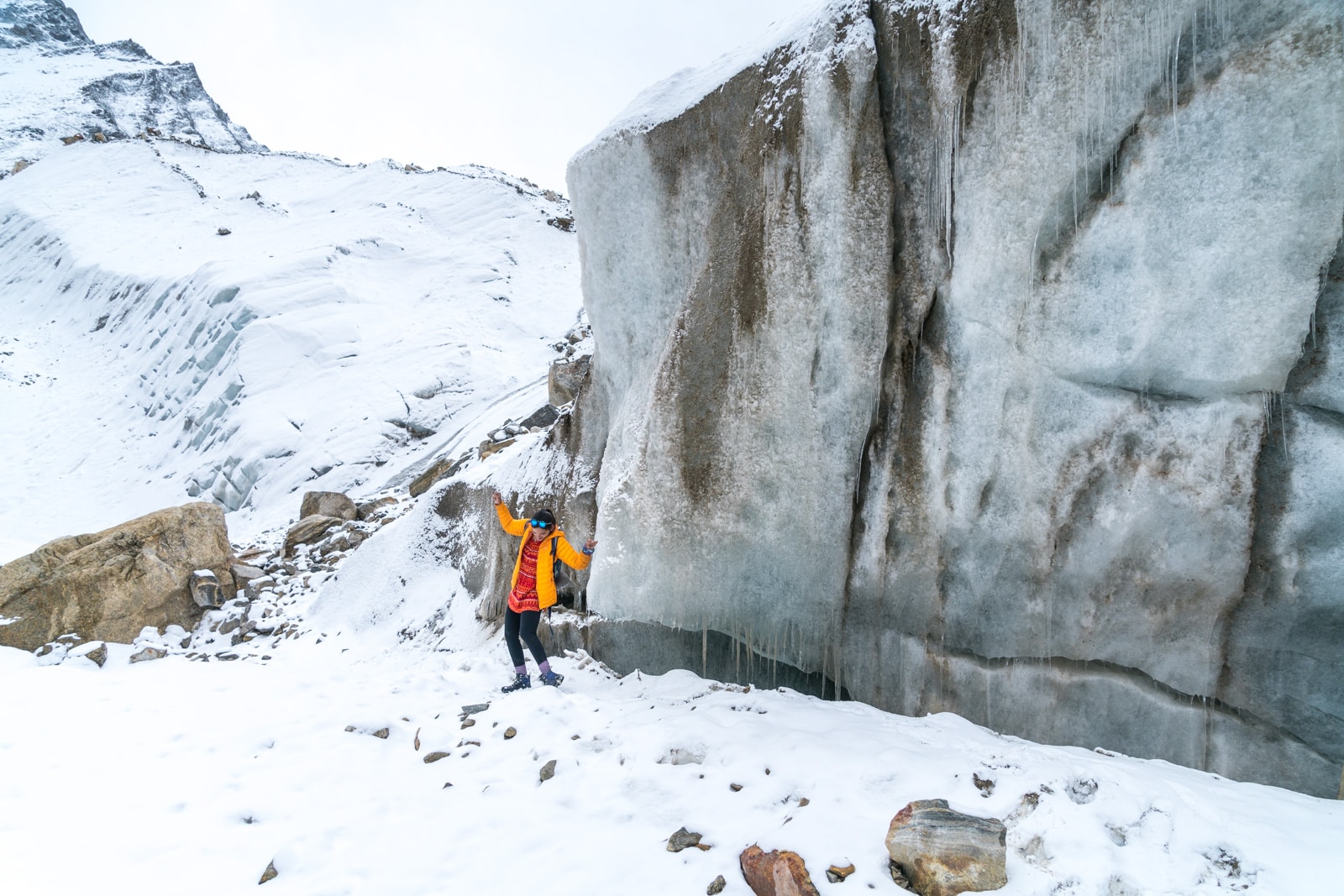
Awww ye!
Extricating myself from the snowdrift, I prance over to the first gap in the river ice. I use my hands to scoop up several sweet, icy cool sips of fresh water.
The struggle was worth it; from finish to start, my Ganga pilgrimage is now complete.
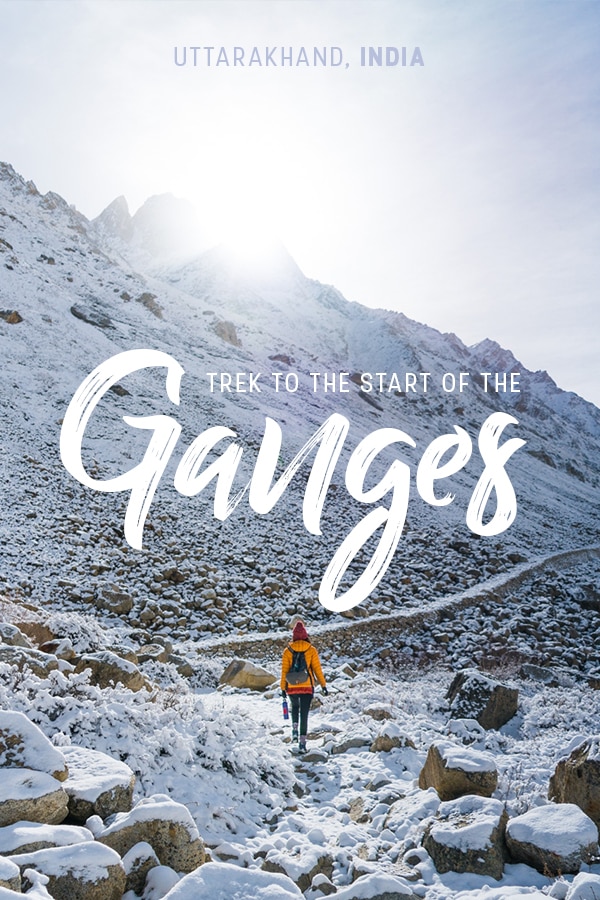
Might be useful? Pin it!
A guide to trekking to the start of the Ganges river in Uttarakhand, India
Trekking to the start of the Ganges is something I recommend to any semi-fit person traveling in India.
The views are utterly stunning, and even if you aren’t a Hindu, being able to drink from the Ganges (without contracting typhoid/hepatitis/cholera/death) is a spiritual experience in and of itself.
In the name of helping other travelers make their way to this pilgrimage place safe and sound, here’s what you need to know about trekking to the start of the Ganges river.
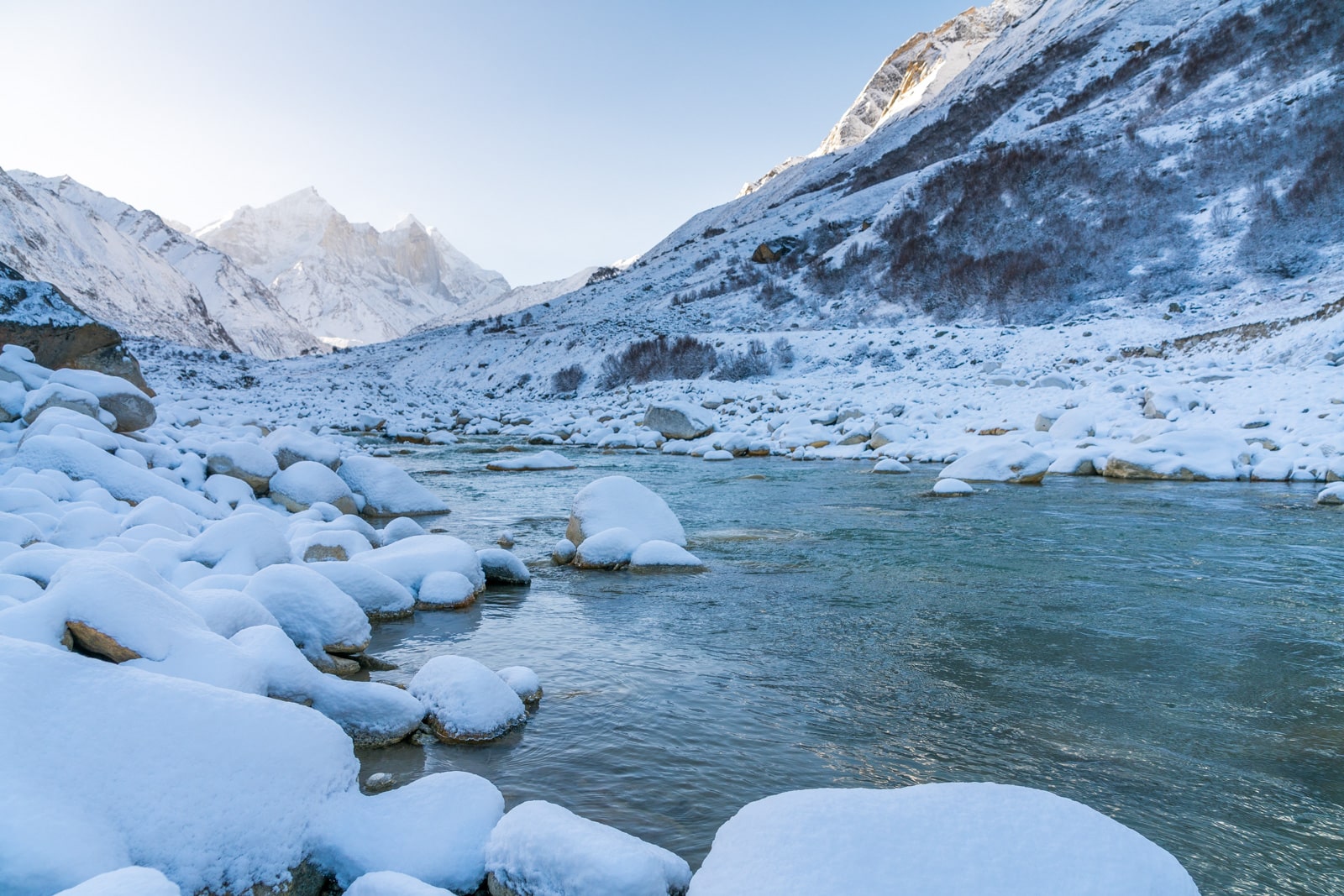
A snowy sunrise near the start of the Bhagirathi River
Where does the Ganges river start?
Several headstreams feed into the Ganges, all formed by glacial melt from the Himalayas.
On paper, the Ganges River begins in Devprayag at the confluence of the Bhagirathi and Alaknanda Rivers. Technically the Alaknanda feeds more water into the Ganges than the Bhagirathi, but in Hindu mythology, the Bhagirathi is believed to be the source of the Ganges’ waters. The Bhagirathi begins at Gangotri Glacier.
Gangotri town, through which the Bhagirathi flows, is believed the point where goddess Ganga first touched down on earth. It’s said that Shiva’s dreadlocks cushioned her fall to earth, and reduced the flow of her waters to rivulets so as not to destroy the land below.
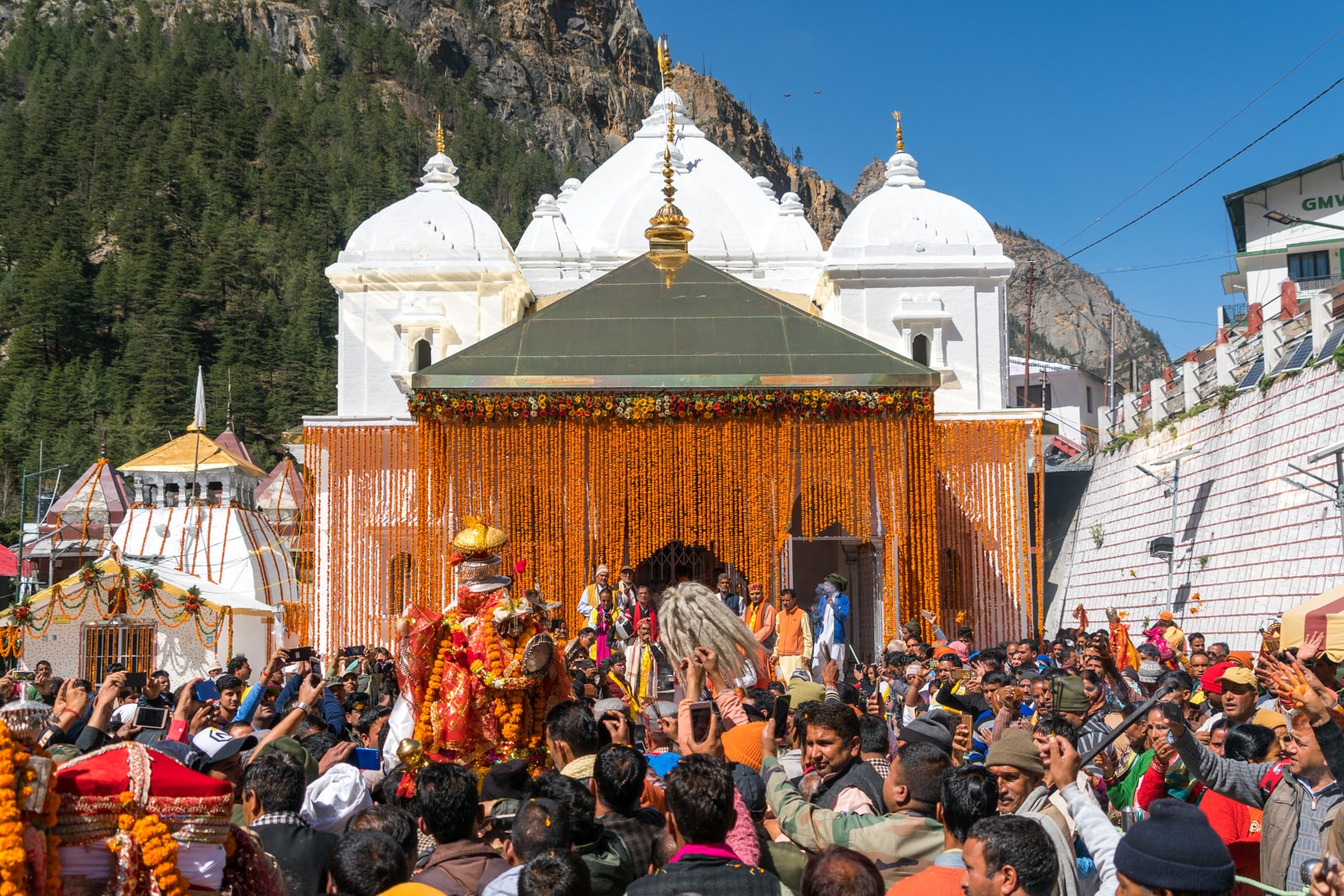
Gangotri temple on its opening day
To begin your trip to the start of the Ganges, you first need to reach Uttarkashi, a town 95 km south of Gangotri.
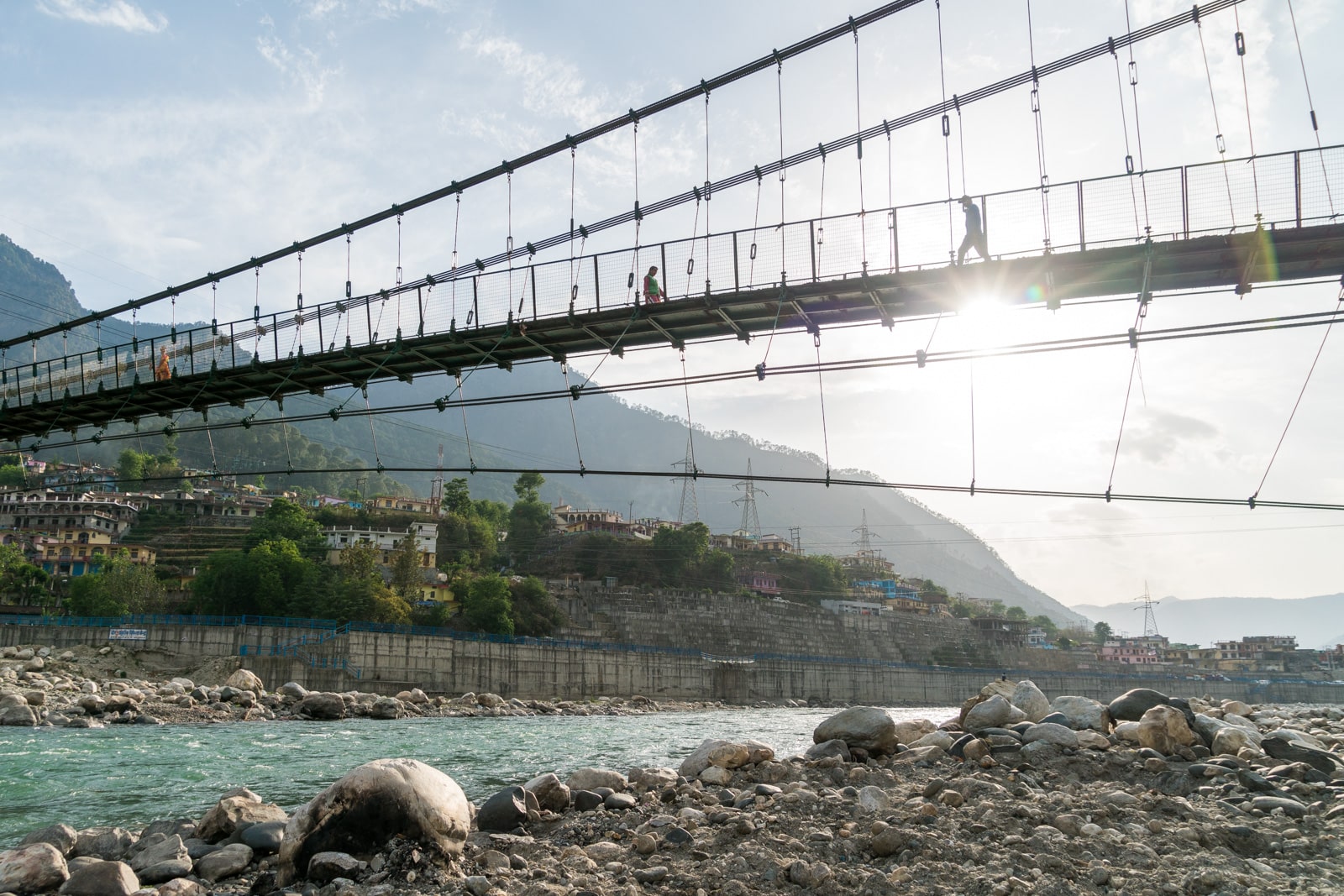
One of several bridges spanning the Bhagirathi River in Uttarkashi
How to get to Uttarkashi
Buses to Uttarkashi are readily available from Haridwar, Rishikesh, and Chamba.
It takes 7 to 8 hours to reach Uttarkashi by bus from Rishikesh, so the earlier you head to the bus stand, the better. In 2018, a government bus ticket from Rishikesh to Uttarkashi cost 240 Rs per person.
If you want to break up your journey in Uttarkashi, there are myriad hotels to choose from. I stayed at Hotel Yamuna-Aditya in the town bazar when traveling to and from Uttarkashi. Before the Gangotri temple opening, a room with two double beds and ensuite with hot water was 600 Rs per night; once season began, I paid 1,000 Rs per night.
Before leaving Uttarkashi, be sure to head to the ATM as there are no ATMs in Gangotri.
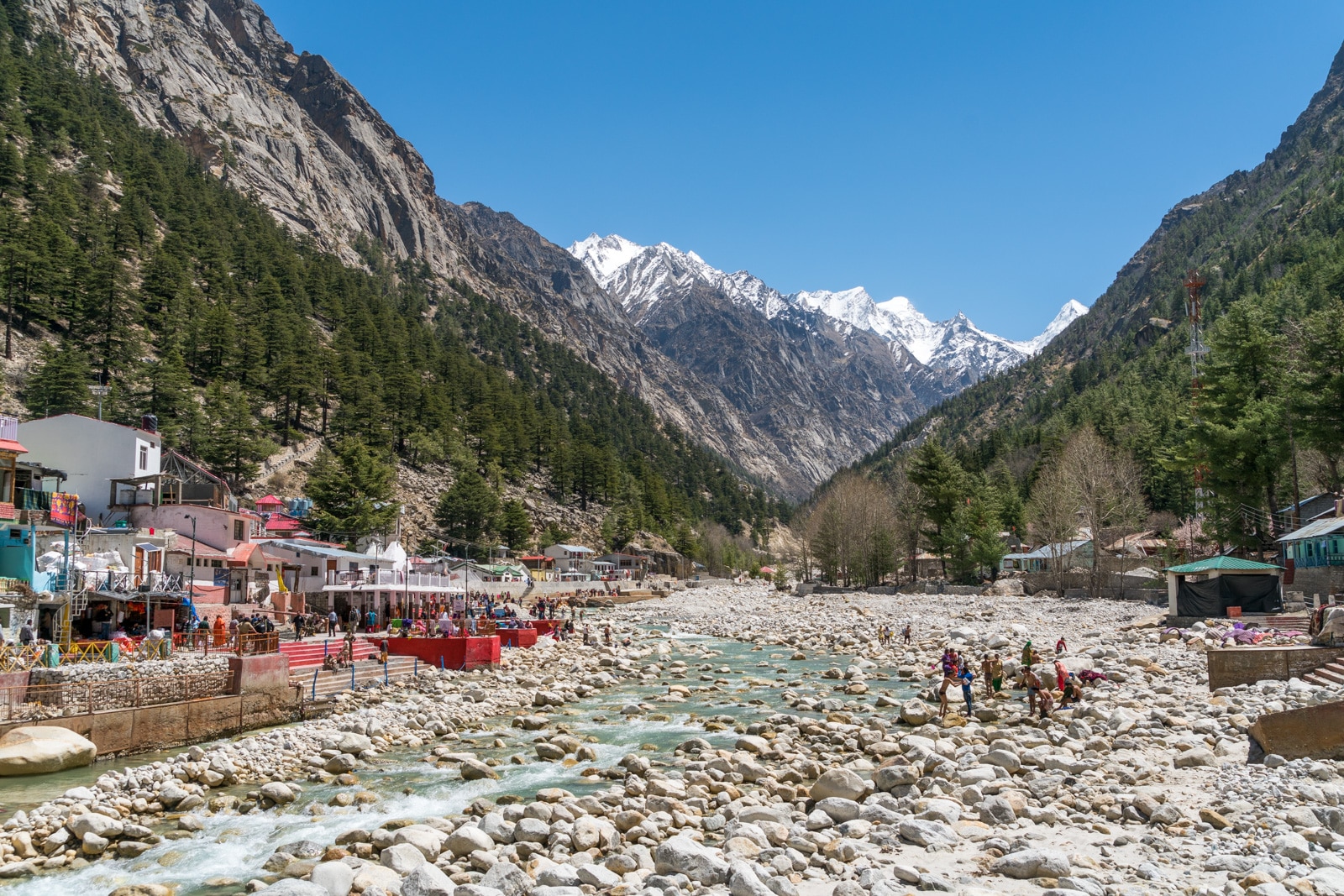
The Bhagirathi River flows right through the center of Gangotri
How to get to Gangotri from Uttarkashi
Gangotri is a small village in northern Uttarakhand, and the starting point for the trek to Gomukh.
It is not occupied year-round due to weather; it comes alive around the opening day of Gangotri temple. The opening day is based on the Hindu calendar, and thus changes each year. In 2018, the temple opened on April 18.
To reach Gangotri from Uttarkashi, you’ll need to hire a taxi or jump in a shared Jeep (Mohindra).
The shared Jeep stand is towards the end of town when following the main road through Uttarkashi; it will be on a small hill on your lefthand side when walking away from the town center.
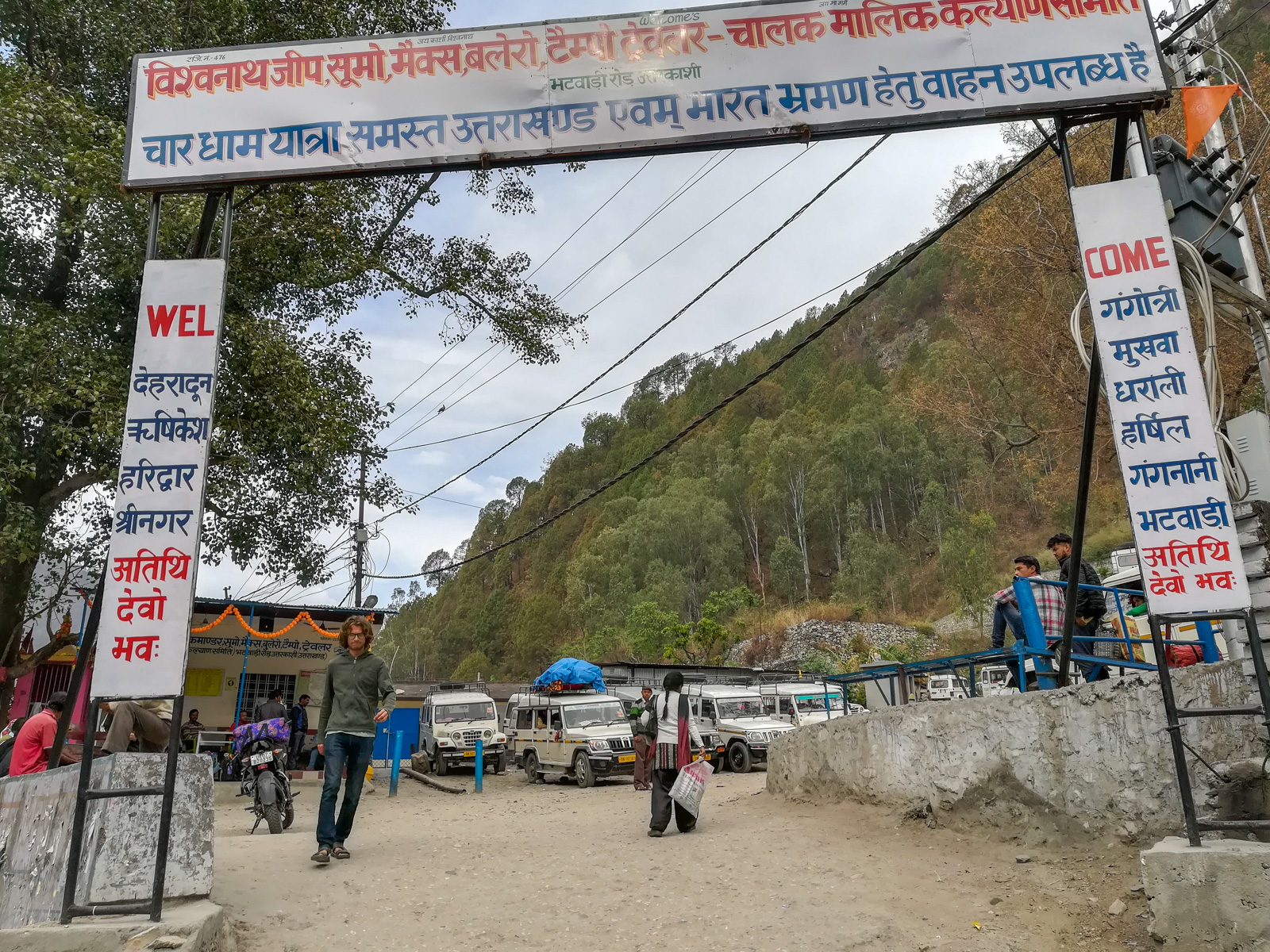
Shared Jeep stand
Jeep seating is on a first come, first serve basis, so be bold if you want a good seat! Anywhere from 10 to 14 passengers can squish into one car, so don’t expect comfort.
Using shared jeeps, the ride from Uttarkashi to Gangotri is 4 to 5 hours along winding mountain roads, and costs 200 Rs per person. The journey was broken up by a stop at an army check post where free chai was handed out to everyone. Score!
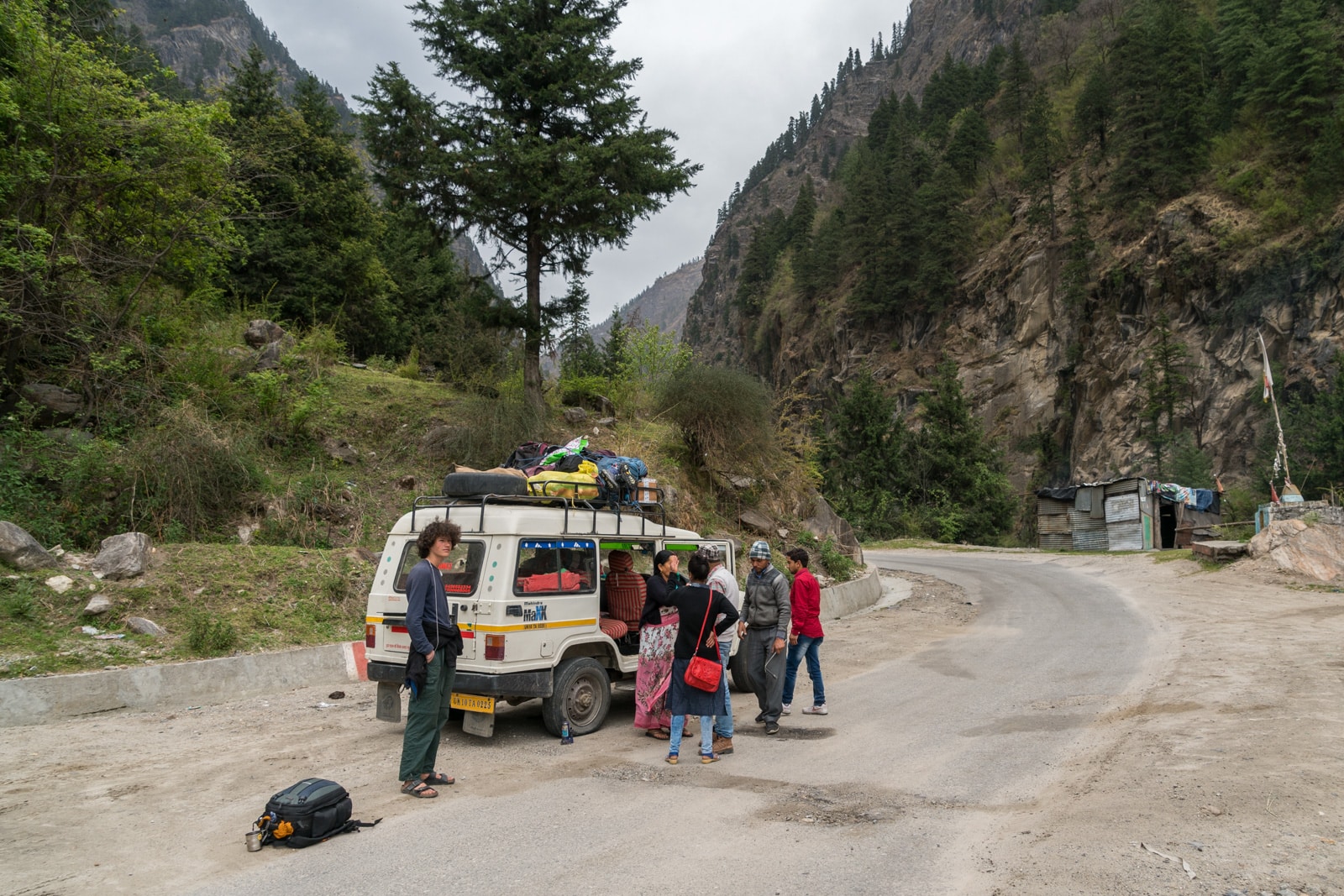
Flat tire stop on the way to Gangotri
Once you reach Gangotri, head into town to find a hotel. There are plenty to choose from; walk into town and cross over the river to find slightly better rooms with cheaper prices. Prices for a double room ranged from 500 to 1,000 Rs per night when I asked.
Note: Mobile networks in Gangotri are not reliable. Only 2G Airtel and BSNL is available, but the signal often cut out for hours at a time.
I recommend taking a couple of days to acclimatize to the altitude in Gangotri before starting your trek. It’s a beautiful place to hang around, and there are several trekking paths you can explore starting from the path leading down from the GVMN Rest House. One leads down to a Pandava cave, while the other leads up a long ways into the mountains.
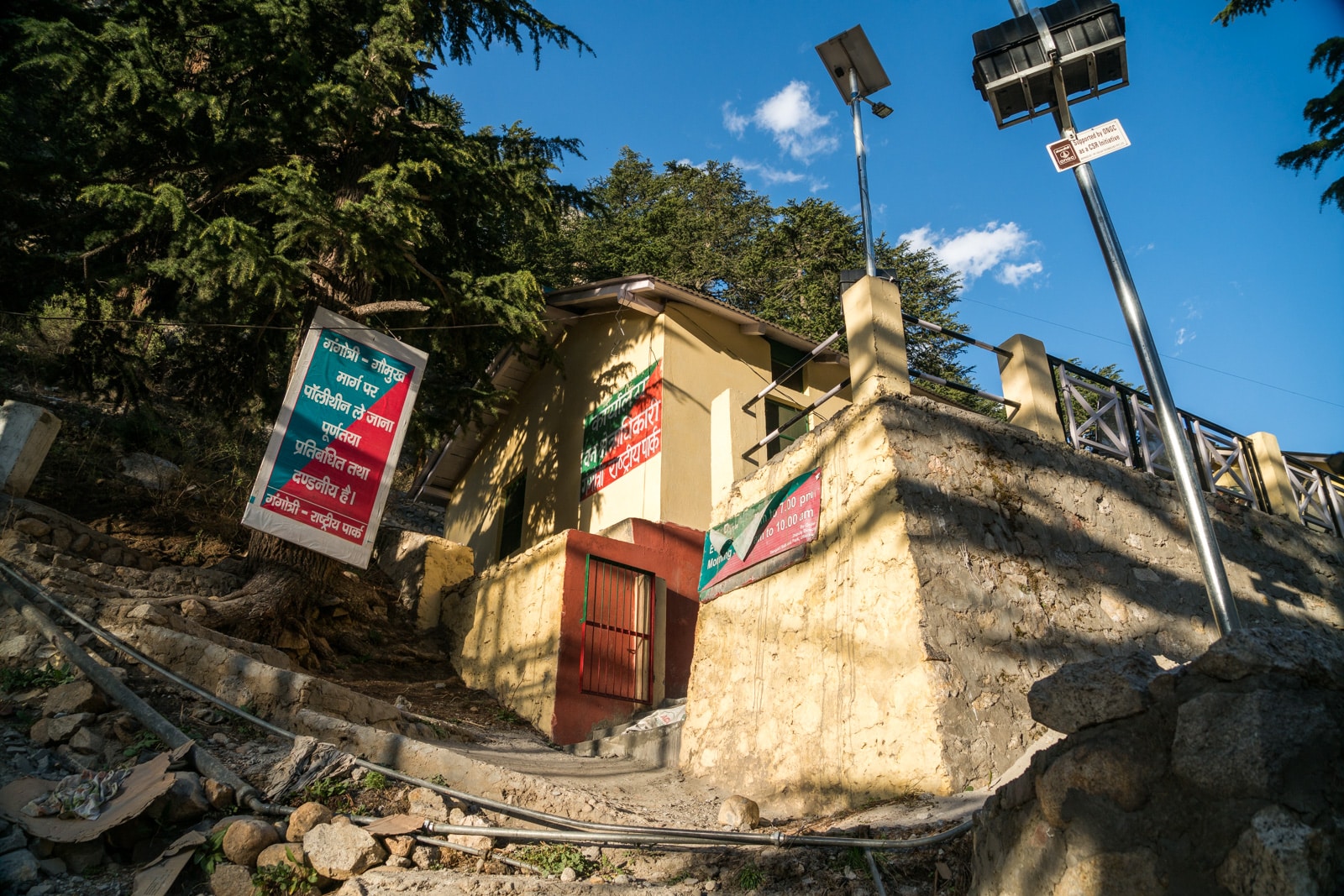
The Forest Department office complex in Gangotri
How to get permits for Gangotri National Park and the Gomukh trek
Regardless of nationality, everyone needs a permit to trek through Gangotri National Park to Gomukh.
Only 150 people are allowed entry into the protected area each day, and permits are only valid for two days. You can stay beyond the two days, but will need to pay an overstay charge for each extra day.
It is not possible to get a permit for independent trekking before the opening of Gangotri temple; only guided groups may apply for permits from Uttarkashi before the opening. The park opens to groups sometime around April 1, depending on the weather.
Apply for your permit at the Forest Department Office at the start of town, close to where shared Jeeps drop off passengers. Look for the red and green sign marking the yellow office building, or ask anyone around about where to get permits.
The Forest Department Office takes permit applications from 8:00 to 10:00 and 17:00 to 19:00 (weirdly enough).
You’ll receive a form to fill out, with basic information plus information of an emergency contact should something go wrong. You also need to bring a copy of your ID card (Indian nationals) or your passport information page and visa (foreign nationals). If you don’t have a copy, never fear—there are a couple of shops with copy machines on the main road through the village.
Gangotri National Park permit costs:
- Indian nationals: 150 Rs per person
- Foreign nationals: 600 Rs per person
- Fee to be paid at check post once you begin your trek
Note: Apparently you can also apply for your Gangotri National Park permit online through this website. Could be useful to ensure you get your foot in the door during high season… however I have not used this service, and cannot say whether or not it works. Proceed with caution.
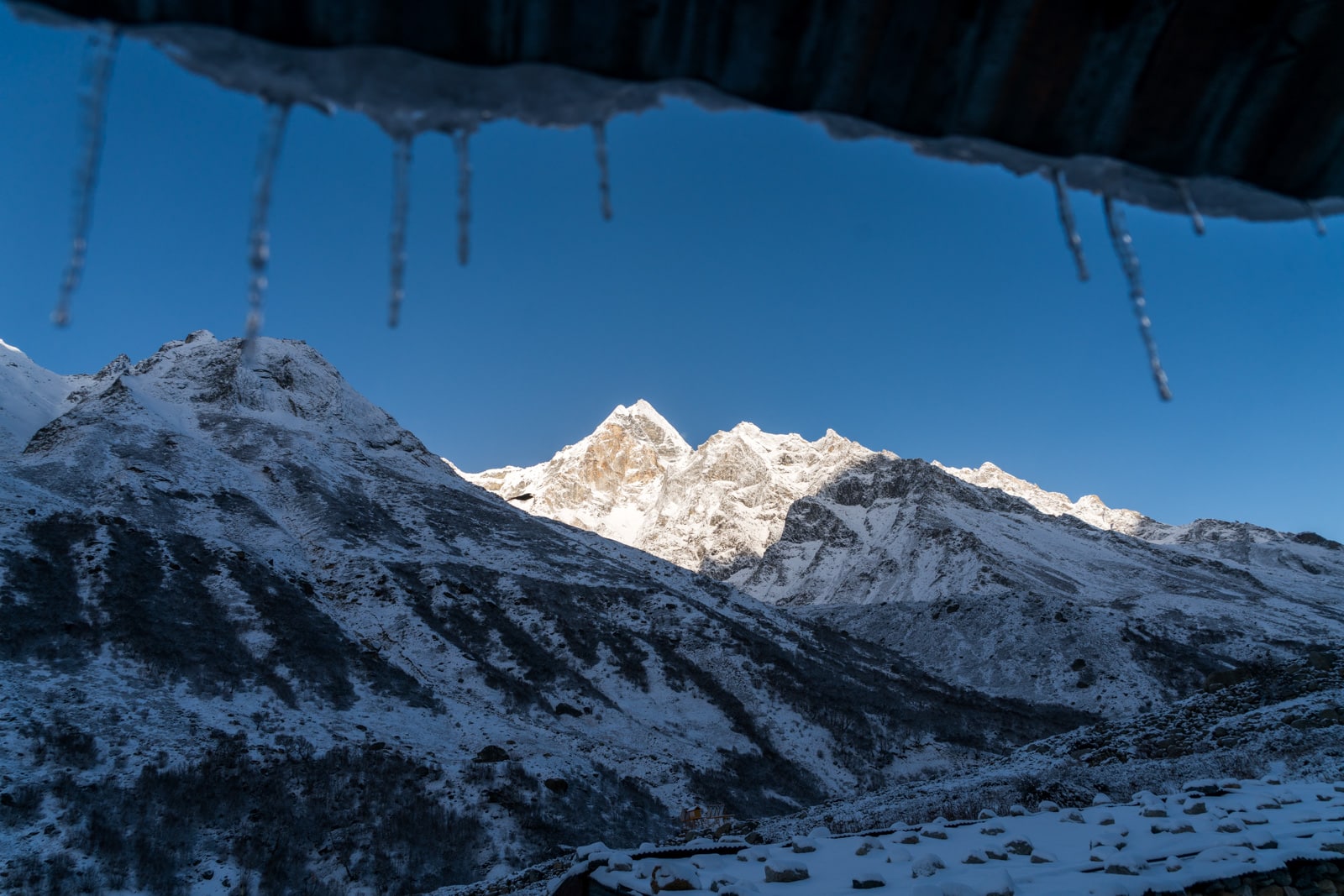
Frosty mornings in the mountains
What to pack for your trek to Gangotri Glacier
The trek to Gomukh takes two days for most people, which means you’ll be spending a night up in the (really damned cold) mountains. Though you won’t need too much in the way of supplies, I recommend packing:
- Warm clothes (obviously)
- A reusable water bottle; can be refilled from mountain streams
- A raincoat or waterproof outer layer
- Snacks for the trek
- Hand sanitizer
- Flashlight
- Something to eat for breakfast on the second day
- Bag to collect your trash
Know that waste is carefully monitored in Gangotri National Park—there are many signs saying plastic is forbidden.
Anything plastic or wrapped (bottles, candy bars, etc.) will be noted down once you enter the park. A deposit will be taken upon entry; if you don’t bring your trash back, you don’t get your deposit back. Which is how things should be, in my humble opinion.
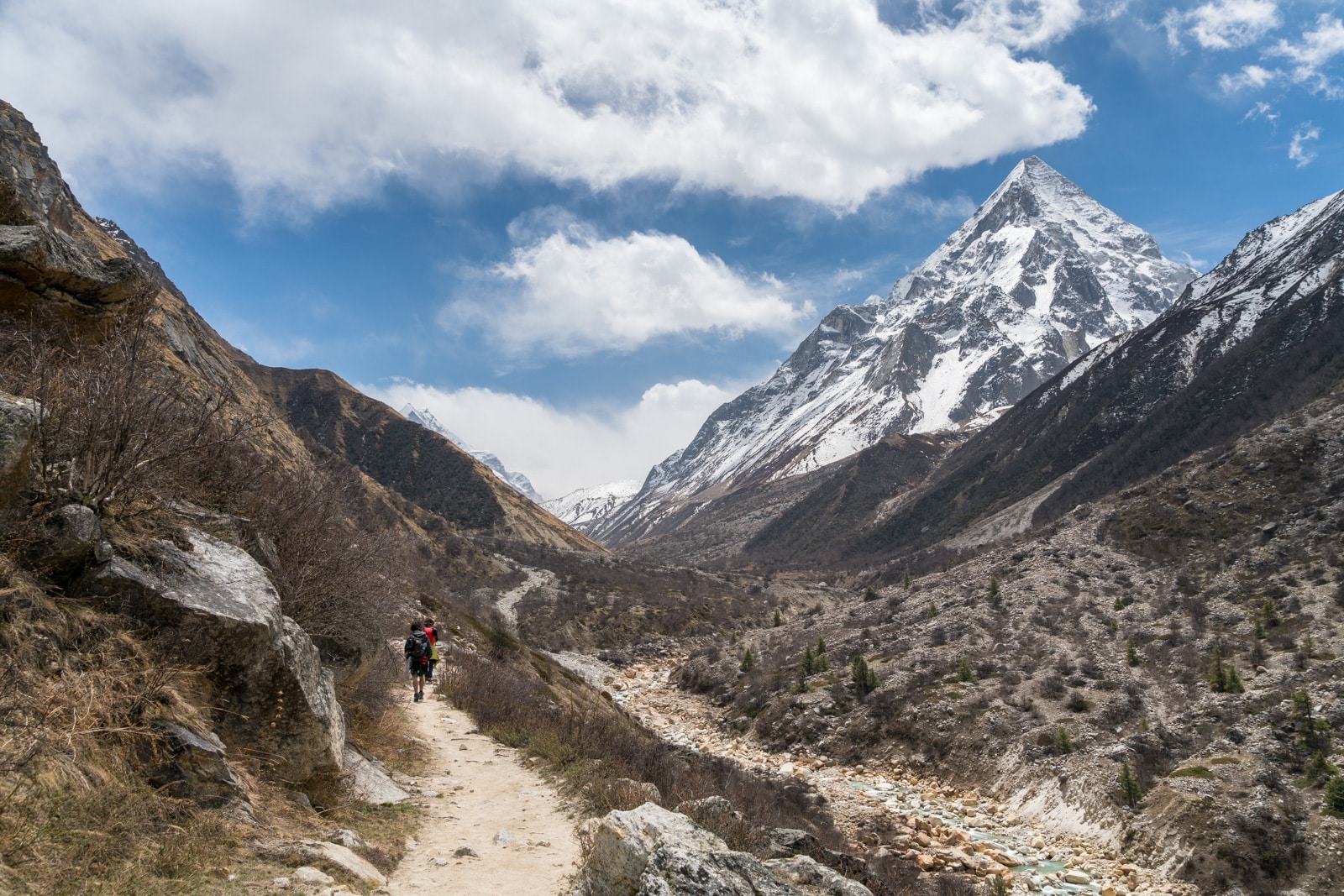
The trail to Gomukh is all kinds of epic
Trekking to Gomukh at Gangotri Glacier
- Trek length: 36 km (Gangotri – Gomukh – Gangotri)
- Time: 1-2 days
- Highest point: 3,892 m
- Accommodation: Ashram or government rest house at Bhojwasa (14 km)
Permit in hand, it’s time to head to the start of the Ganges! I recommend setting off early to ensure you can reach your destination during the day—ideally you should start around 6:00 or 7:00.
The trail to Gomukh begins with some very nondescript steps from an open paved area around 100 meters beyond Gangotri temple.
Walk for 30 minutes, and you’ll eventually reach the entrance gate to the national park, where your details will be noted down and you can pay your entrance fee (cash only). The ranger in the office was very friendly and spoke good English—if you have any questions or concerns, ask them here.
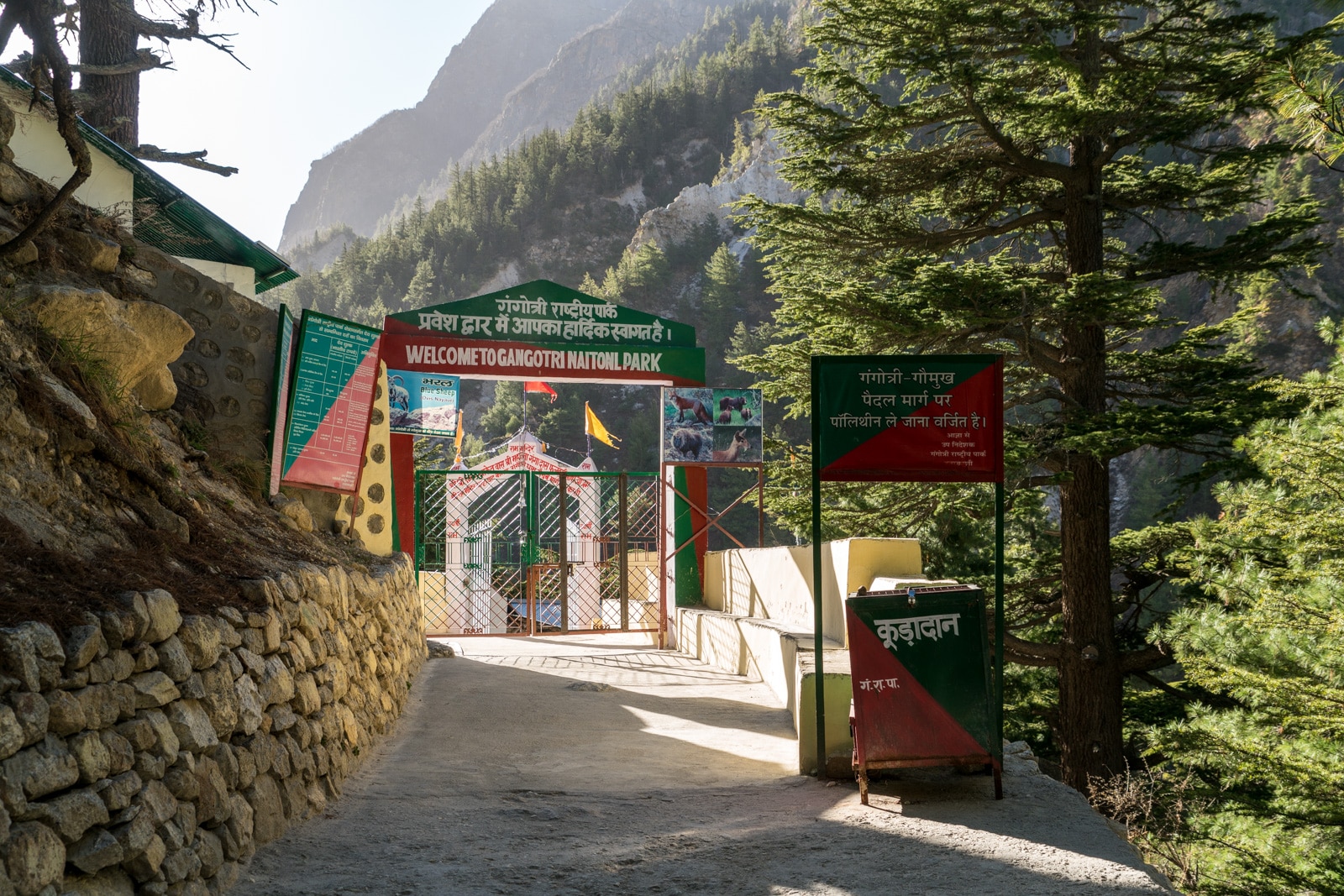
Entrance gate to the park
From then on, it’s time to walk through some certifiably epic mountain views. The trek isn’t too steep, and the path is very clear. A small part of it is even paved! Nevertheless, it’s long, high, and out in direct sunlight, so take your time and listen to your body.
In April there weren’t any places to stop and get chai or snacks along the way, though I passed the shells of several huts. Some army men offered tea at their check post in Chirbasa about 9 km in on the second day—perhaps more is available later on in the season.
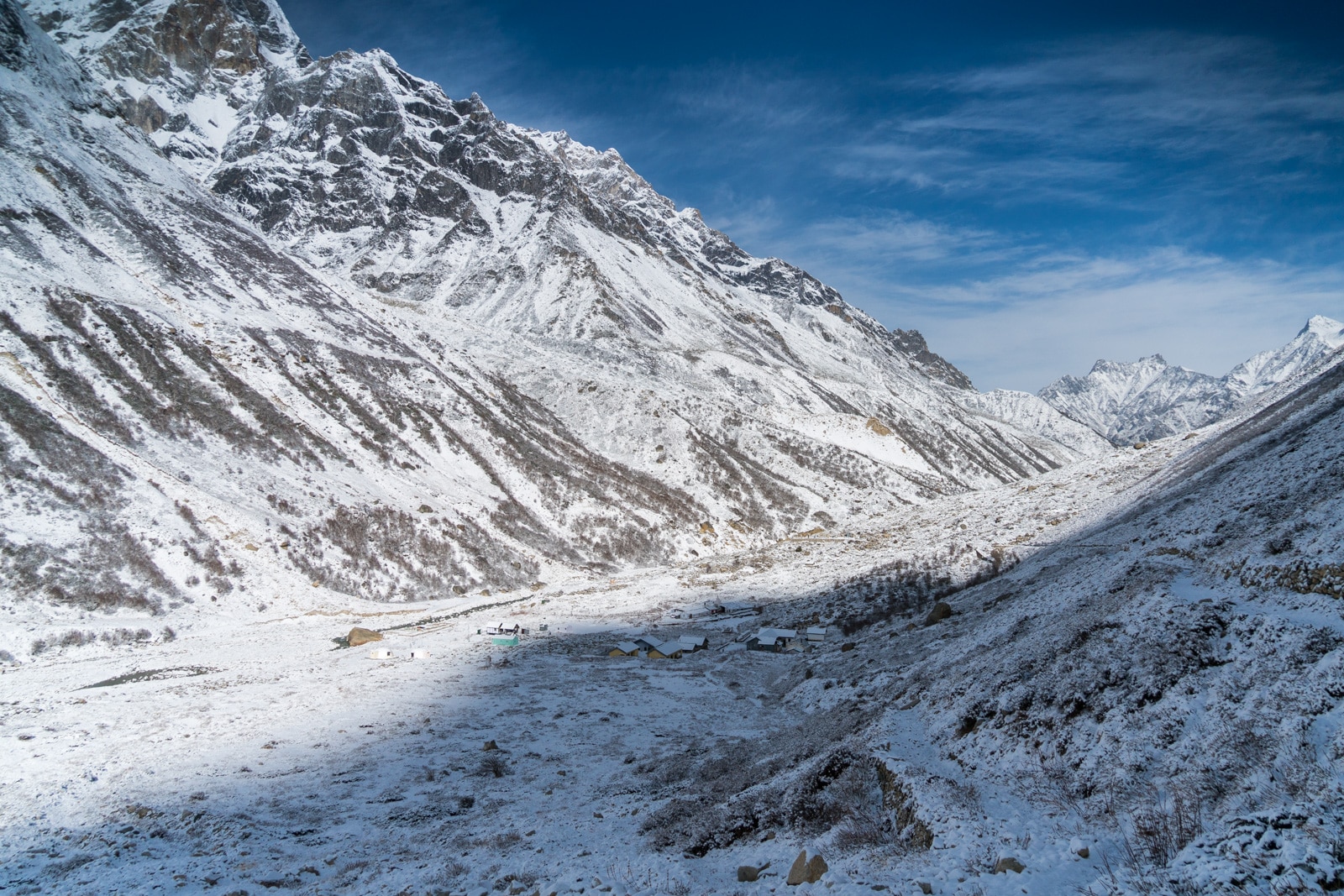
Bhojwasa in the shadows of the mountains
Reaching Bhojwasa village
Bhojwasa is the last “village” before Gangotri Glacier, 14km into the trek. There are some winding turns through landslide-prone gravel fields right before you crest the hill over Bhojwasa—tread carefully and don’t linger!
I met (fit) people who walked the distance in 4 hours; it took me 6 hours given I was a shriveled sick shell of a human who needed to rest every 2 seconds after the first few kilometers. If you’re older and not particularly fit, it could take you more time.
Accommodation is available in Bhojwasa, but don’t expect much—it’s a small collection of basic AF buildings at around 3,800 m above sea level. There’s a government rest house, some igloo-like accommodation (requires permission from Forest Department), and several ashrams you can stay in.
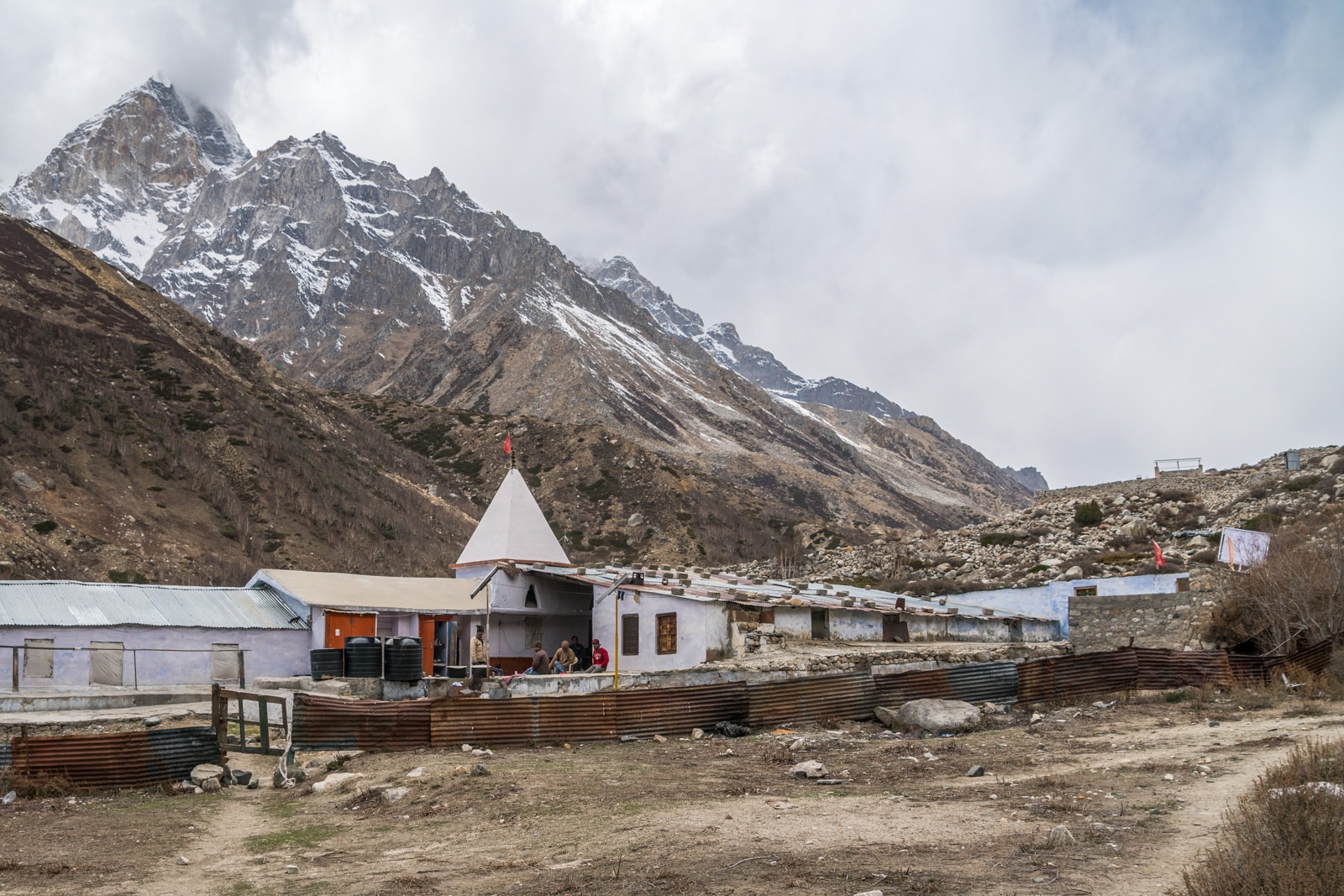
Lal Baba Ashram
I recommend staying in Lal Baba Ashram, the first building you’ll encounter on your right hand side. The staff are friendly and very helpful, and it’s only 350 Rs per person for a night of accommodation plus two simple meals (dal and rice) and as much black tea as you’d like. They start serving lunch at 11:00, and dinner around 19:00. Bedrooms are basic, but include enough blankets to keep anyone warm and snuggly despite the cold.
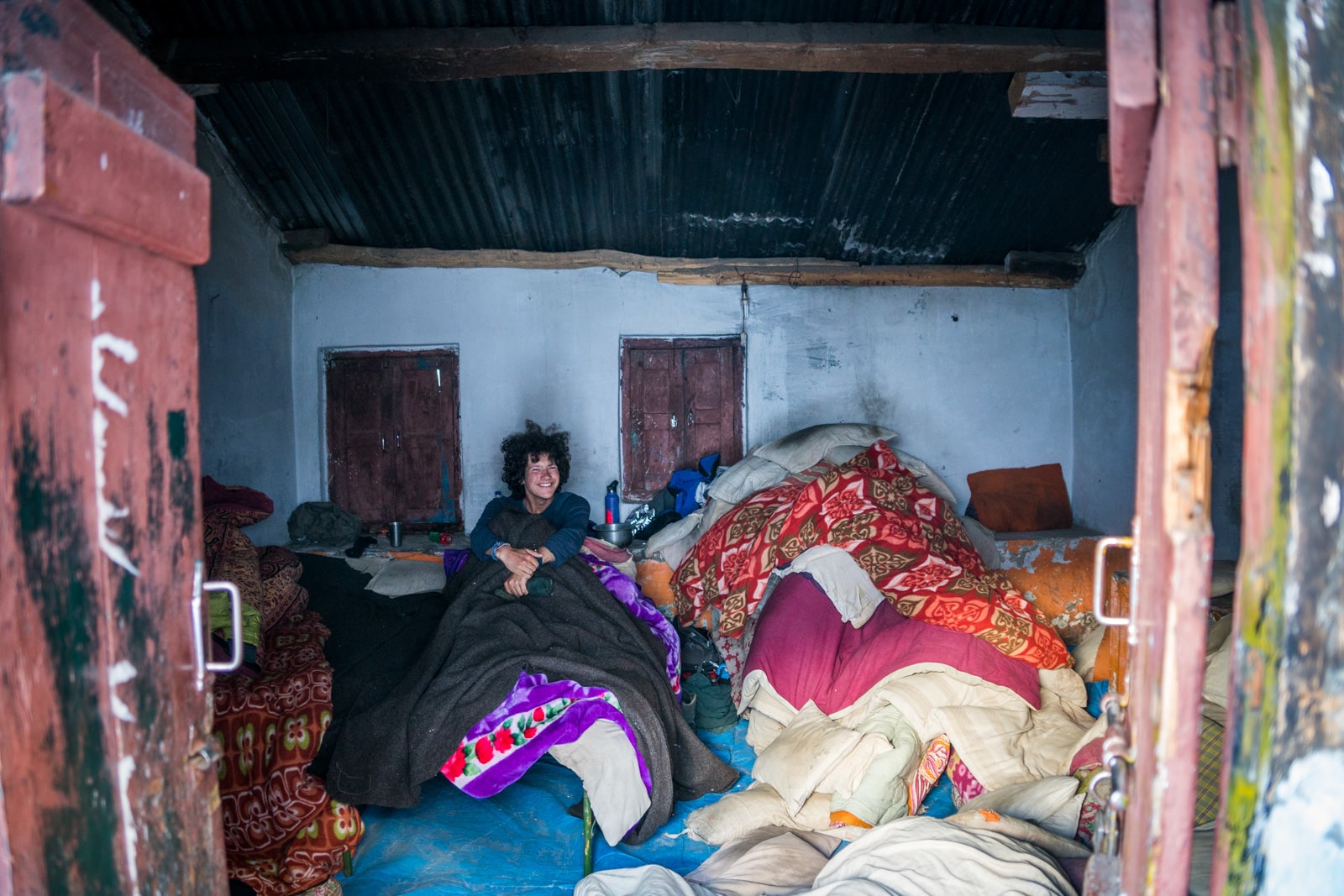
My friend Levi hiding in one of the beds at Lal Baba Ashram… next to their massive blanket stores!
The GVMN rest house is also 350 Rs per person, but the price doesn’t include food. However, their canteen has more food variety—think Maggi noodles, packaged snacks, and basic curry/rice combos.
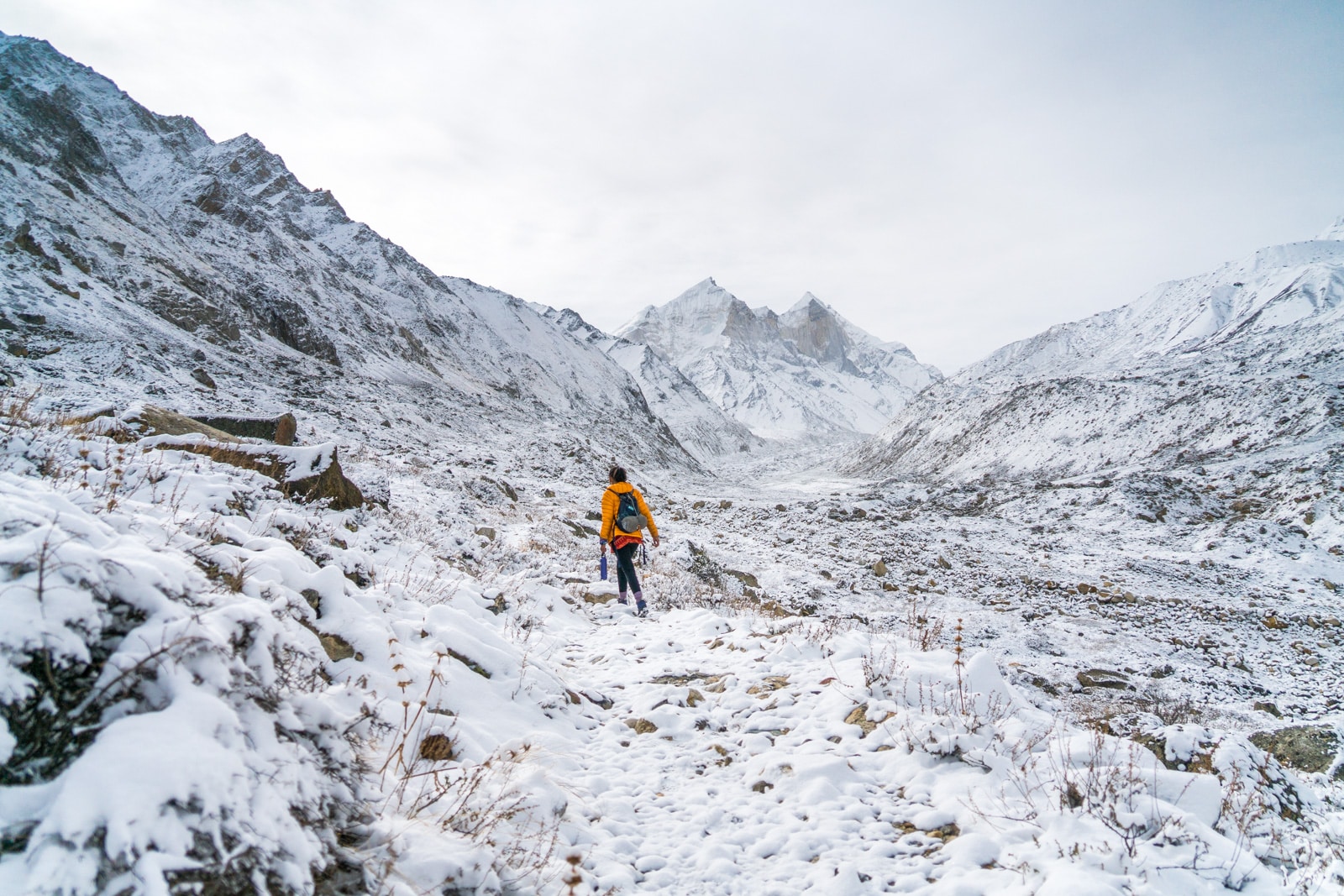
Snow making things a bit more complicated on the way to Gomukh
Trekking from Bhojwasa to Gomukh
The last leg of the journey is 8 km round trip—4 to the glacier, and 4 back to Bhojwasa. Expect to take 2 to 3 hours to reach the glacier.
When I trekked at the end of April, fresh snowfall obscured the path, and it was difficult to find my way to the glacier. However, once the snow melted, the path was a bit clearer.
If stuck in a similar situation, look for little rock pyramids marking the way, and know that you need to cross the river around 500 m before the glacier. The last part of the way will take you across a flat field filled with rocks and small boulders.
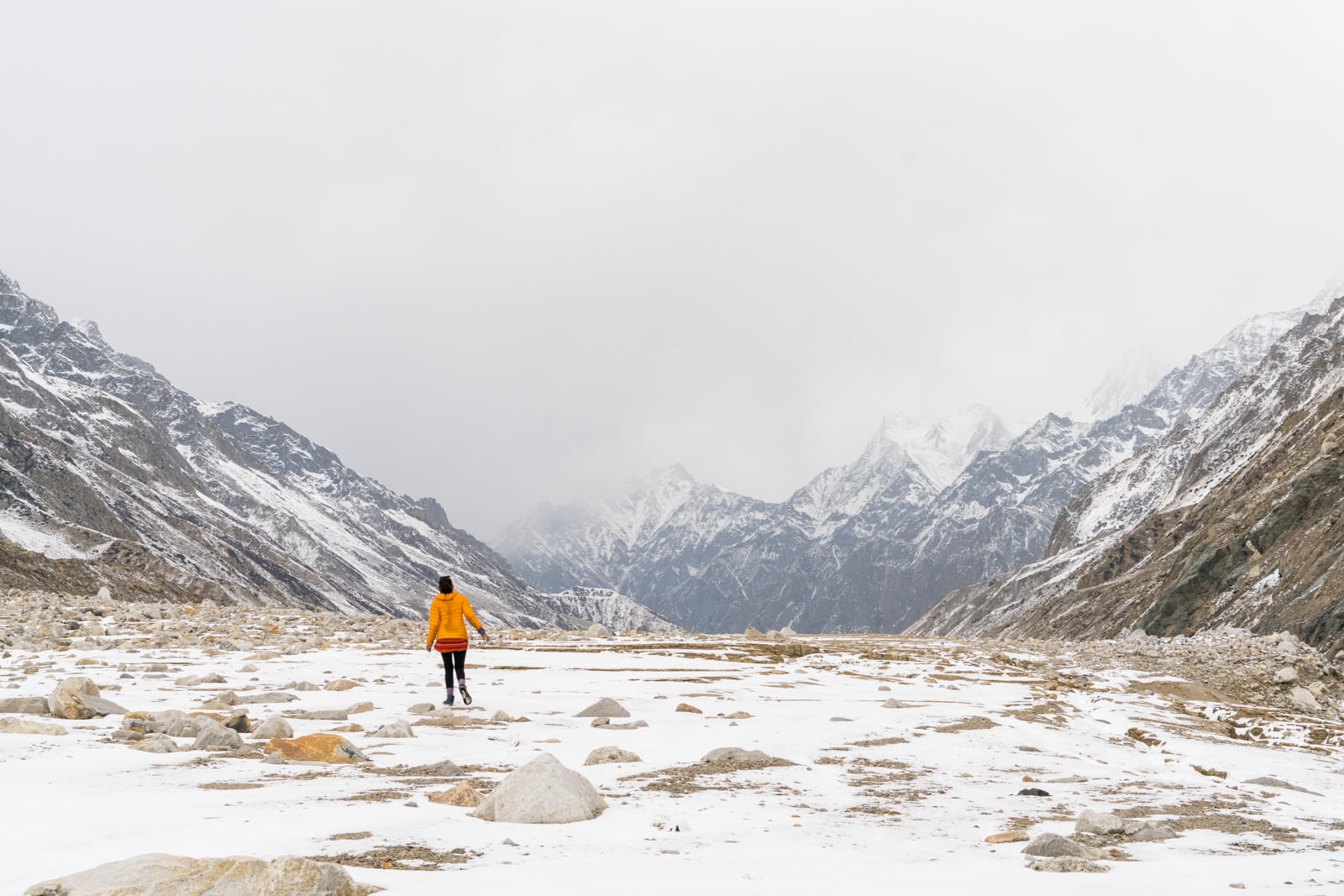
Open space before Gomukh
An ice cave used to mark the starting point of the river, but part of the glacier collapsed, and the cave is now hidden by ice.
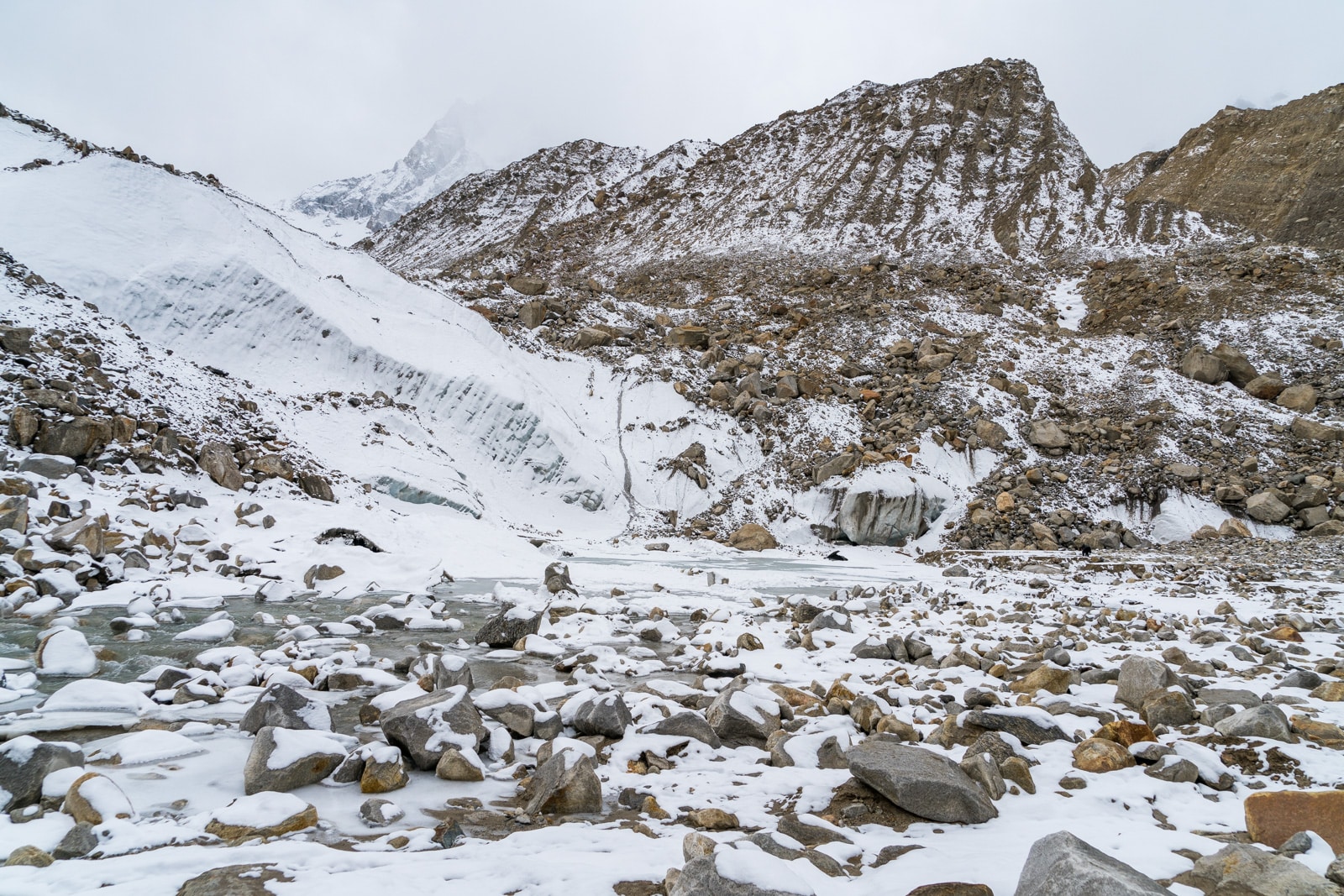
Gomukh, starting point of the Ganga! The lump of ice on the right is the last remnants of the ice cave.
Nevertheless, the area is stunning, and on a clear day you should be able to see the towering Mount Shivling behind the glacier. Take selfies, collect water, do whatever—you’ve made it to the start of the Ganges!
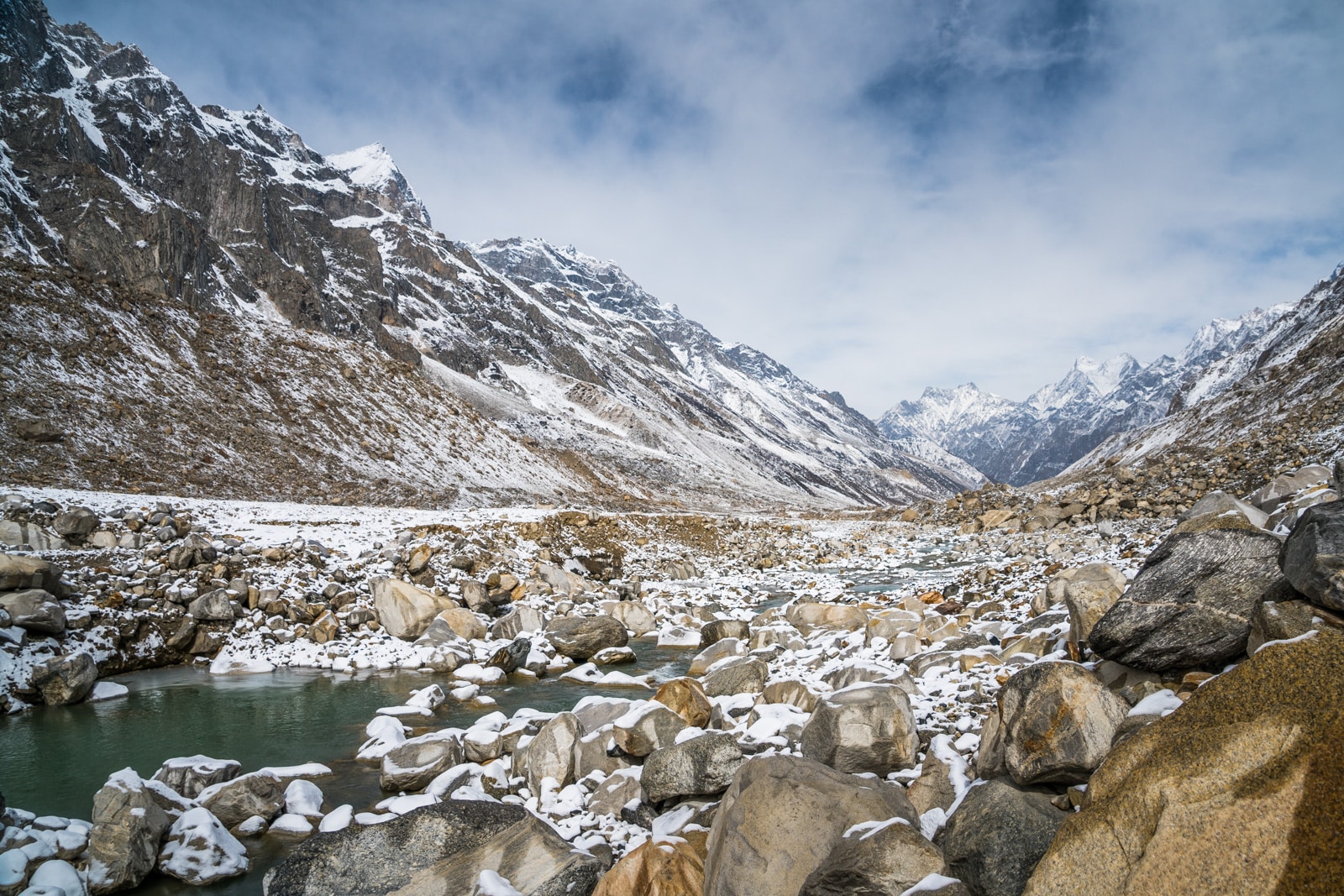
The trek back down to Gangotri
Returning to Gangotri, Uttarkashi, and beyond
Unfortunately, all good things must come to an end, and you’ll need to return to the real world eventually.
Expect to take 3 to 5 hours to return to Gangotri from Bhojwasa.
From Gangotri, you can find shared Jeeps back to Uttarkashi at the main gate into the town. Jeeps, as always, leave when (too) full.
In Uttarkashi, buses leave from the bus stand in the center of town. If you want to head back to Haridwar or Rishikesh, aim to leave early, ideally before 10:00 or 11:00 to ensure you get on a bus.
As always, safe travels, and take care! Travelers who have already visited Gangotri and Gomukh, feel free to leave tips and advice for others in the comments.
Still on an Indian trekking kick? Don’t miss my guide to the Sham Valley trek in Ladakh.
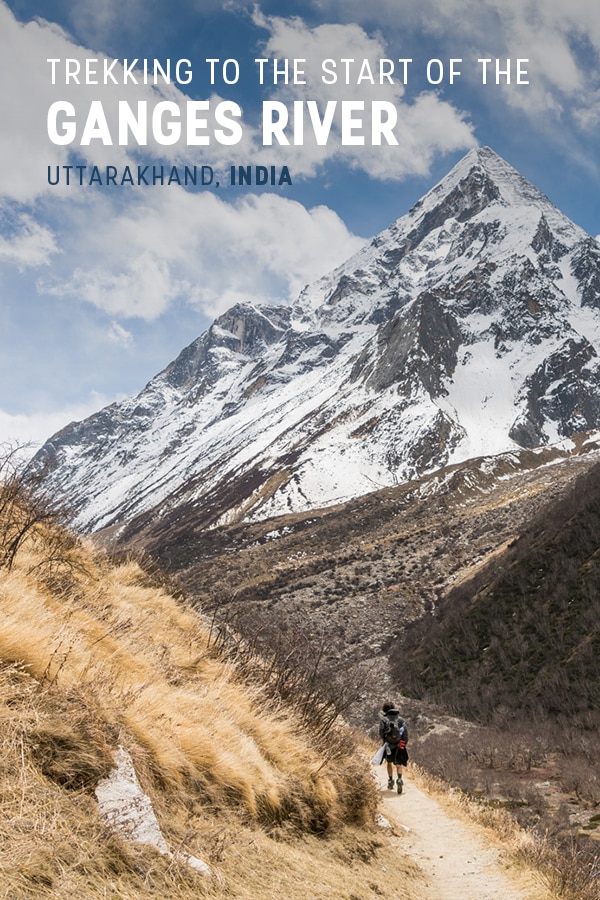
Was this helpful? Pin it!
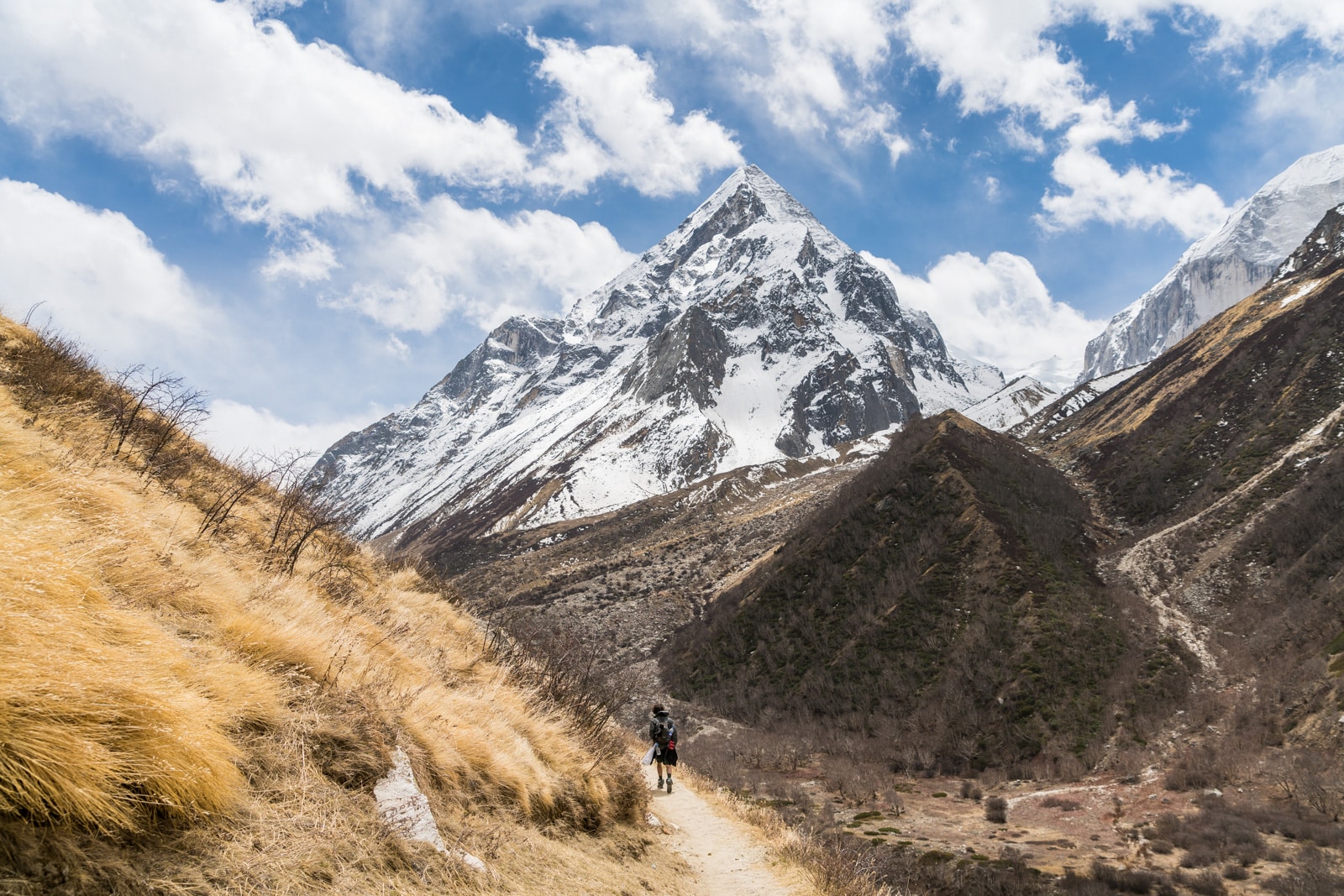


After Gomukh, this trek really begins to shine. So, from just above the Ganges Originating Point, you walk beyond the glacier and begin a steep ascent to the right, which leads to Tapovan, which is the foot of multiple Himalayan mountains. One error in the blog is that Gomukh Glacier, not Gangotri Glacier, is the name of the glacier from whence the Ganges originates. The name of the national park is Gangotri. here is also a trek to do is Kedarnath yatra.